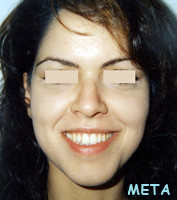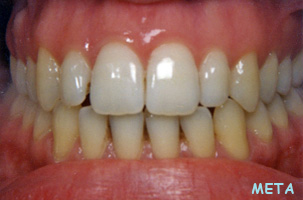Cooperation with other Dentistry Specialists

Adult patients with extensive dental problems might need an orthodontic therapy in order to support therapies carried out by other dental specialties. On the other hand, an orthodontic treatment might require the support of other dental or medical specializations.
Dentistry


Orthodontic treatment requires close cooperation with the patient’s dentist. Before starting an orthodontic treatment a patient must be checked for cavities, gingivitis or may need to have some teeth extracted according to the needs of the orthodontic treatment. During the orthodontic treatment regular inspection of oral cleaning is required. Keeping the patient’s dentist informed about the orthodontic treatment is obviously necessary.
Pedodontics

The pediatric dentist’s is trained to eliminate the fears of young patients. The pediatric dentist and the orthodontist usually cooperate on a regular basis throughout an orthodontic treatment.
Prosthetics


When lost teeth are not replaced for a long time, other teeth tend to take their places, and prosthetic work (bridges, partial dentures, implant) is thwarted. Pre-prosthetic orthodontics arranges teeth so that they are placed in their proper positions, thus creating the conditions for a successful prosthesis.
Periodontics


Periodontal disease makes the teeth unstable as the bone that supports them gradually subsides. Thus, the teeth display crowding, spaces or rotations. Orthodontic treatment restores teeth to their correct positions and stabilizes them to ensure longevity in the mouth.
Gnathology
Neglected orthodontic problems often lead to problems of the temporomandibular joint (the area in front of the ears where there is a joint of the lower jaw to the head). These problems have as symptoms severe and persistent headaches, “clicking sounds” as the mouth opens and closes, etc. The treatment of the underlying orthodontic problems in cooperation with the treatment of a Gnathologist can relieve patients of the cause and hence the symptoms.
Otolaryngology (Ear Nose and Throat):
Ear Nose and Throat (ENT) problems are often among the causes of various orthodontic -skeletal abnormalities. Such ENT problems are oversized tonsils, adenoids, a divergent nasal septum, chronic rhinitis, allergies etc. In these cases, collaboration with an ENT specialist is required.
Oral Surgery

Cooperation with an oral surgeon is required in certain orthodontic treatments. For instance teeth extractions which are of a high degree of difficulty, removal of impacted wisdom teeth, treatment of cysts and / or disclosure of teeth which are for some reason encapsulated within the bone of the jaw.
This cooperation is obviously necessary in the case of adult patients with pronounced skeletal abnormalities. The orthodontist will position the teeth in each jaw (pre-surgical orthodontic treatment) and when this positioning is complete, the oral surgeon (orthodontics surgery) will address the size and the relative position of the jaws. Finally, the orthodontist will carry out (post operative orthodontics) the final and more precise placement of teeth. This treatment protocol must be followed to achieve a good and stable result.
Speech therapy
Certain orthodontic problems are likely to have an impact on the patient’s speech, As a result some patients present articulation problems and there is a need for collaboration with speech therapists during an orthodontic treatment. Young patients with cleft palates have particularly nasal speech. In these cases, speech therapy is absolutely essential from an early age.
Plastic Surgery


Often the disharmonies in the facial features are not only due to skeletal orthodontic problems but also arise from problems in other areas of the face (nose, ears, and chin). The role of plastic surgery is particularly important in supporting and promoting the effects of an orthodontic therapy, and vice versa.
ORTHOGNATHIC SURGERY
Problems that arise due to poor positioning of the jaws can be disguised with proper orthodontic movement of the teeth and an acceptable result can be achieved despite the existing skeletal abnormalities. However, when differences in size and / or relevant relationships of the jaws are strong, they cannot be corrected with only an orthodontic treatment. In these cases, Orthognathic surgery is required. In problems involving both the teeth and skeleton, it is not possible for Orthognathic surgery to replace orthodontics, and vice versa. Following a joint protocol of collaboration, the orthodontist and oral surgeon after a review of the patient take the diagnostic records, (casts, radiographs, photographs), devise a treatment plan and define the responsibilities of each specialty. Treatment usually involves three phases:
1. Pre surgical orthodontics
The orthodontist is required to bring the teeth of each jaw in such positions that will lead to a balanced occlusion, after the completion of the surgical operation. The duration of the orthodontic treatment may vary from 12 to 24 months.




2. Surgery:
The surgical operation is scheduled after the successful completion of pre surgical orthodontics. The operation is sometimes extensive and is done under general – and not local – anesthesia and often requires a few days of hospital stay. During the operation the surgeon adjusts the size and position of each jaw to the skull, as well as the relative position of the jaws. After the surgery and during a period of approximately 20 days the teeth are immobilized by orthodontic appliances, according to the surgeon’s instructions.




3. Post operative orthodontic treatment:
After the period of immobilization, the patient returns to the orthodontist who is now engaged in post-surgery tooth placements. Since the proper relative jaw positions have been attained, a final and precise movement of the teeth is possible. The duration of this type of orthodontic treatment varies from 4 to 12 months.








These combined surgical – orthodontic treatments often have spectacular results, since they not only benefit the mouth and the smile but the entire face. Patients may have to undergo a lengthy treatment, but at the end the result immensely affects their lives.
